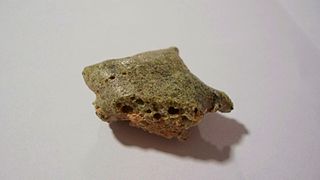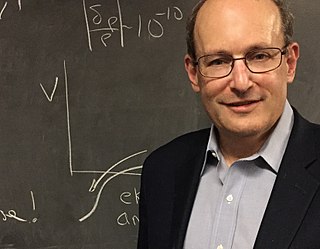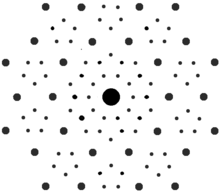
In geology and mineralogy, a mineral or mineral species is, broadly speaking, a solid chemical compound with a fairly well-defined chemical composition and a specific crystal structure that occurs naturally in pure form.

A quasiperiodic crystal, or quasicrystal, is a structure that is ordered but not periodic. A quasicrystalline pattern can continuously fill all available space, but it lacks translational symmetry. While crystals, according to the classical crystallographic restriction theorem, can possess only two-, three-, four-, and six-fold rotational symmetries, the Bragg diffraction pattern of quasicrystals shows sharp peaks with other symmetry orders—for instance, five-fold.

Trinitite, also known as atomsite or Alamogordo glass, is the glassy residue left on the desert floor after the plutonium-based Trinity nuclear bomb test on July 16, 1945, near Alamogordo, New Mexico. The glass is primarily composed of arkosic sand composed of quartz grains and feldspar that was melted by the atomic blast. It was first academically described in American Mineralogist in 1948.
The year 1984 in science and technology involved some significant events.

An aperiodic tiling is a non-periodic tiling with the additional property that it does not contain arbitrarily large periodic regions or patches. A set of tile-types is aperiodic if copies of these tiles can form only non-periodic tilings. The Penrose tilings are the best-known examples of aperiodic tilings.

A micrometeorite is a micrometeoroid that has survived entry through the Earth's atmosphere. Usually found on Earth's surface, micrometeorites differ from meteorites in that they are smaller in size, more abundant, and different in composition. The IAU officially defines meteorites as 30 micrometers to 1 meter; micrometeorites are the small end of the range (~submillimeter). They are a subset of cosmic dust, which also includes the smaller interplanetary dust particles (IDPs).

Robert Ammann was an amateur mathematician who made several significant and groundbreaking contributions to the theory of quasicrystals and aperiodic tilings.

Paul Joseph Steinhardt is an American theoretical physicist whose principal research is in cosmology and condensed matter physics. He is currently the Albert Einstein Professor in Science at Princeton University, where he is on the faculty of both the Departments of Physics and of Astrophysical Sciences.

Biomineralization, also written biomineralisation, is the process by which living organisms produce minerals, often to harden or stiffen existing tissues. Such tissues are called mineralized tissues. It is an extremely widespread phenomenon; all six taxonomic kingdoms contain members that are able to form minerals, and over 60 different minerals have been identified in organisms. Examples include silicates in algae and diatoms, carbonates in invertebrates, and calcium phosphates and carbonates in vertebrates. These minerals often form structural features such as sea shells and the bone in mammals and birds.

Dan Shechtman is the Philip Tobias Professor of Materials Science at the Technion – Israel Institute of Technology, an Associate of the US Department of Energy's Ames National Laboratory, and Professor of Materials Science at Iowa State University. On April 8, 1982, while on sabbatical at the U.S. National Bureau of Standards in Washington, D.C., Shechtman discovered the icosahedral phase, which opened the new field of quasiperiodic crystals.

Aguilarite is an uncommon sulfosalt mineral with formula Ag4SeS. It was described in 1891 and named for discoverer Ponciano Aguilar.
Peter James Lu, PhD (陸述義) is a post-doctoral research fellow in the Department of Physics and the School of Engineering and Applied Sciences at Harvard University in Cambridge, Massachusetts. He has been recognized for his discoveries of quasicrystal patterns in medieval Islamic architecture, early precision compound machines in ancient China, and man's first use of diamond in neolithic China.

Khatyrkite is a rare mineral which is mostly composed of copper and aluminium, but may contain up to about 15% of zinc or iron. Its chemical structure is described by an approximate formula (Cu,Zn)Al2 or (Cu,Fe)Al2. It was discovered in 1985 in a placer in association with another rare mineral cupalite. These two minerals have only been found at 62°39′11″N174°30′02″E in the area of the Iomrautvaam, a tributary of the Khatyrka river, in the Koryak Mountains, in Anadyrsky District, Chukotka, Russia. Analysis of one of the samples containing khatyrkite showed that the small rock was from a meteorite. A geological expedition has identified the exact place of the original discovery and found more specimens of the Khatyrka meteorite. The mineral's name derives from the Khatyrka zone where it was discovered. Its type specimen is preserved in the Mining Museum in Saint Petersburg, and parts of it can be found in other museums, such as Museo di Storia Naturale di Firenze.
Cupalite is a rare mineral which is mostly composed of copper and aluminium, but might contain up to several percent of zinc or iron; its chemical structure is therefore described by an approximate formula (Cu,Zn)Al or (Cu,Fe)Al. It was discovered in 1985 in placers derived from serpentine, in association with another rare mineral khatyrkite (CuAl2). Both minerals are thus far restricted to the area of the Iomrautvaam, in the Khatyrka ultramafic (silicon-poor) zone of the Koryak–Kamchatka fold area, Koryak Mountains, Anadyrsky District, Chukotka Autonomous Okrug, Far Eastern Federal District, Russia. The mineral name derives from cuprum (Latin for copper) and aluminium. Its holotype (defining sample) is preserved in the Mining Museum in Saint Petersburg, and parts of it can be found in other museums, such as Museo di Storia Naturale di Firenze.

A Penrose tiling is an example of an aperiodic tiling. Here, a tiling is a covering of the plane by non-overlapping polygons or other shapes, and aperiodic means that shifting any tiling with these shapes by any finite distance, without rotation, cannot produce the same tiling. However, despite their lack of translational symmetry, Penrose tilings may have both reflection symmetry and fivefold rotational symmetry. Penrose tilings are named after mathematician and physicist Roger Penrose, who investigated them in the 1970s.

Luca Bindi is an Italian geologist. He holds the Chair of Mineralogy and Crystallography and is the Head of the Department of Earth Sciences of the University of Florence. He is also a research associate at the Istituto di Geoscienze e Georisorse of the National Research Council (Italy) (CNR). He has received national and international scientific awards that include the President of the Republic Prize 2015 in the category of Physical, Mathematical and Natural Sciences. Since 2019 is a Member of the National Academy of Lincei.

Kamanio Chattopadhyay is an Indian materials engineer and an honorary professor at the Indian Institute of Science, Bengaluru. He is the chair of the Mechanical Sciences Division of IISc and a former chair of the Department of Materials Engineering.
Trace metal stable isotope biogeochemistry is the study of the distribution and relative abundances of trace metal isotopes in order to better understand the biological, geological, and chemical processes occurring in an environment. Trace metals are elements such as iron, magnesium, copper, and zinc that occur at low levels in the environment. Trace metals are critically important in biology and are involved in many processes that allow organisms to grow and generate energy. In addition, trace metals are constituents of numerous rocks and minerals, thus serving as an important component of the geosphere. Both stable and radioactive isotopes of trace metals exist, but this article focuses on those that are stable. Isotopic variations of trace metals in samples are used as isotopic fingerprints to elucidate the processes occurring in an environment and answer questions relating to biology, geochemistry, and medicine.

Fumarole minerals are minerals which are deposited by fumarole exhalations. They form when gases and compounds desublimate or precipitate out of condensates, forming mineral deposits. They are mostly associated with volcanoes following deposition from volcanic gas during an eruption or discharge from a volcanic vent or fumarole, but have been encountered on burning coal deposits as well. They can be black or multicoloured and are often unstable upon exposure to the atmosphere.
Dov I. Levine is an American-Israeli physicist, known for his research on quasicrystals, soft condensed matter physics, and statistical mechanics out of equilibrium.















